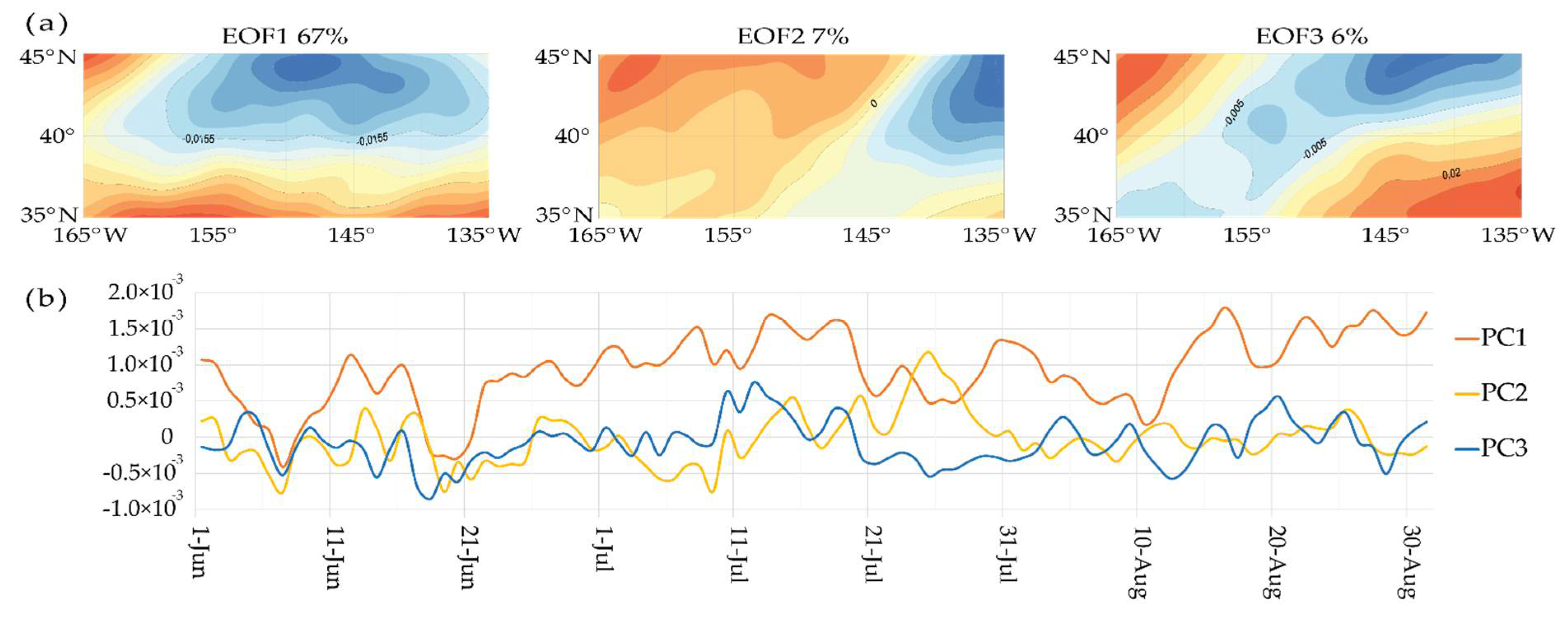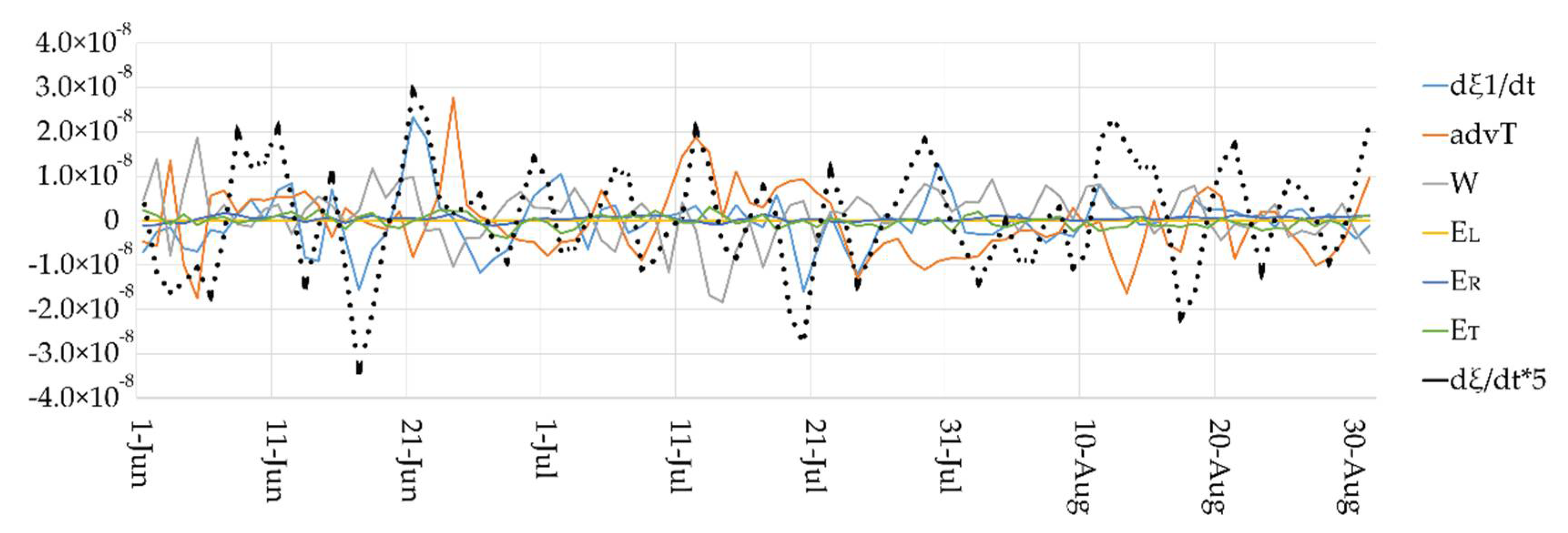The Vorticity Budget of an Individual Atmospheric Vortex for the Hawaiian High †
Abstract
:1. Introduction
2. Materials and Methods
2.1. Re-analysis Data
2.2. Vorticity Budget Equation
3. Results
3.1. Spatial Structure of the Hawaiian Anticyclone Vorticity
3.2. Spatial Structure of the Hawaiian High Vorticity
4. Discussion
4.1. The Equation for the Coefficient y1 (t) at the First Mode of the EOF Decomposition
4.2. Estimation of the “Noise” Component in the Vorticity Budget Equation
5. Conclusions
Author Contributions
Funding
Institutional Review Board Statement
Informed Consent Statement
Data Availability Statement
Conflicts of Interest
References
- Palmen, E.; Newton, C. Atmospheric Circulation Systems: Their Structure and Physical Interpretation; Academic Press: New York, NY, USA; London, UK, 1969. [Google Scholar]
- Zabusky, N.J.; Hughes, M.N.; Roberts, K.V.J. Contour dynamics for the Euler equations in two-dimensions J. Comp. Phys. 1979, 30, 96–106. [Google Scholar] [CrossRef]
- Rudeva, I.; Gulev, S.K. Composite analysis of the North Atlantic extratropical cyclones in NCEP/NCAR reanalysis. Mon. Wea. Rew. 2011, 139, 1419–1446. [Google Scholar] [CrossRef]
- Hannachi, A.; Jolliffe, I.T.; Stephenson, D.B. Empirical orthogonal functions and related techniques in atmospheric science: A review. Int. J. Climatol. 2007, 27, 1119–1152. [Google Scholar] [CrossRef]
- Kislov, A.V.; Sokolikhina, N.N.; Semenov, E.K.; Tudrii, K.O. Analyzing the vortex as an integral formation: A case study for the blocking anticyclone of 2010. Russ. Meteorol. Hydrol. 2017, 42, 222–228. [Google Scholar] [CrossRef]
- Kislov, A.V.; Sokolikhina, N.N.; Semenov, E.K.; Tudrii, K.O. Blocking Anticyclone in the Atlantic Sector of the Arctic as an Example of an Individual Atmospheric Vortex. Atmos. Clim. Sci. 2017, 7, 323–336. [Google Scholar] [CrossRef]
- Petrosyants, M.A.; Semenov, E.K.; Gushchina, D.Y. Atmospheric Circulation in the Tropics: Climate and Variability; Maks Press: Moscow, Russian, 2005. (In Russian) [Google Scholar]
- Hersbach, H.; Bell, B.; Berrisford, P.; Biavati, G.; Horányi, A.; Muñoz Sabater, J.; Nicolas, J.; Peubey, C.; Radu, R.; Rozum, I.; et al. ERA5 hourly data on pressure levels from 1979 to present. Copernicus Climate Change Service (C3S) Climate Data Store (CDS) 2018. [Google Scholar] [CrossRef]
- Petterssen, S. Weather Analysis and Forecasting; McGraw-Hill: New York, NY, USA, 1956. [Google Scholar]
- Majda, A.; Franzke, C.; Khouider, B. An applied mathematics perspective on stochastic modelling for climate. Philos. Transactions. Ser. A Math. Phys. Eng. Sci. 2008, 366, 2429–2455. [Google Scholar] [CrossRef] [PubMed]
- Majda, A.; Franzke, C.; Crommelin, D. Normal forms for reduced stochastic climate models. Proc. Natl. Acad. Sci. USA 2009, 106, 3649–3653. [Google Scholar] [CrossRef] [PubMed]
- Majda, A.; Timofeyev, I.; Vanden-Eijnden, E. A mathematical framework for stochastic climate models. Commun. Pure Appl. Math. 2001, 54, 891–974. [Google Scholar] [CrossRef]



| dξ1/dt | AT | W | ET | ER |
|---|---|---|---|---|
| 0.58 | −0.02 | −0.30 | 0.14 | 0.10 |
Publisher’s Note: MDPI stays neutral with regard to jurisdictional claims in published maps and institutional affiliations. |
© 2022 by the authors. Licensee MDPI, Basel, Switzerland. This article is an open access article distributed under the terms and conditions of the Creative Commons Attribution (CC BY) license (https://creativecommons.org/licenses/by/4.0/).
Share and Cite
Mukhartova, I.; Zheleznova, I.; Nesvyatipaska, A.; Kislov, A. The Vorticity Budget of an Individual Atmospheric Vortex for the Hawaiian High. Environ. Sci. Proc. 2022, 19, 4. https://doi.org/10.3390/ecas2022-12853
Mukhartova I, Zheleznova I, Nesvyatipaska A, Kislov A. The Vorticity Budget of an Individual Atmospheric Vortex for the Hawaiian High. Environmental Sciences Proceedings. 2022; 19(1):4. https://doi.org/10.3390/ecas2022-12853
Chicago/Turabian StyleMukhartova, Iuliia, Irina Zheleznova, Anastasia Nesvyatipaska, and Alexander Kislov. 2022. "The Vorticity Budget of an Individual Atmospheric Vortex for the Hawaiian High" Environmental Sciences Proceedings 19, no. 1: 4. https://doi.org/10.3390/ecas2022-12853
APA StyleMukhartova, I., Zheleznova, I., Nesvyatipaska, A., & Kislov, A. (2022). The Vorticity Budget of an Individual Atmospheric Vortex for the Hawaiian High. Environmental Sciences Proceedings, 19(1), 4. https://doi.org/10.3390/ecas2022-12853






